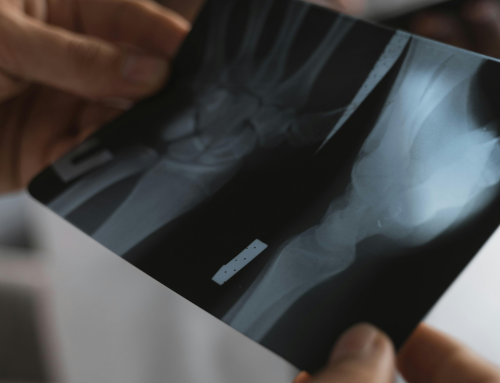When you experience a bone fracture, your body immediately jumps into action to heal the injury. This natural response is both complex and fascinating, involving a series of stages that ensure the bone repairs itself efficiently. One of the earliest and most critical stages requires inflammation. But what exactly happens during this phase, and why is it so crucial for bone healing? How can modern technology, like the Low-Intensity Pulsed Ultrasound (LIPUS) device, support and enhance this natural healing process? Let’s delve into the science of bone repair and discover how innovations in medical technology are revolutionizing recovery from bone fractures.

Understanding Bone Fracture Inflammation
The moment a bone fractures, the body initiates an inflammatory response to protect the area and start the healing process. This reaction is characterized by swelling, warmth, redness, and pain around the fracture site. These symptoms are not merely signs of injury but indicate the body's active healing mechanisms at work.
Why Inflammation is Crucial
- Recruits Healing Cells: It signals the recruitment of immune cells and stem cells to the fracture site. These cells are essential for cleaning the damage and laying down new bone.
- Prepares for New Bone Formation: The inflammatory stage sets the stage for the subsequent phases of healing, including soft callus formation, hard callus formation, and bone remodelling.
Without this initial inflammatory response, the later stages of bone healing would be compromised, leading to delayed healing or even non-union of the fracture.
The Stages of Bone Healing
After the initial inflammatory phase, bone healing progresses through several stages:
1. Soft Callus Formation
Following inflammation, the body begins to produce a soft callus around the fracture site. This cartilaginous tissue provides a temporary scaffold for new bone to form.
2. Hard Callus Formation
The soft callus gradually mineralizes into a hard callus, providing more substantial support and progressively bridging the gap between the broken bone ends.
3. Bone Remodelling
Finally, the hard callus is remodelled into new bone, restoring the bone's original shape and strength. This stage can take several months to complete, depending on the severity of the fracture and the individual's overall health.
The Role of Technology in Enhancing Bone Healing
Technology plays a pivotal role in the journey to optimal health, offering innovative solutions that support the body's natural healing processes. One such breakthrough is the Low-Intensity Pulsed Ultrasound (LIPUS) technology, embodied in devices like the Melmak LIPUS device. This non-invasive technology represents a significant advancement in the treatment of bone fractures, working in harmony with the body's natural healing mechanisms.
What is LIPUS?
LIPUS stands for Low-Intensity Pulsed Ultrasound, a technology that uses mechanical forces in the form of ultrasound waves to stimulate the healing of bones. This process activates cell reproduction and protein expression, enhancing cellular behaviour at the fracture site.
The Science Behind LIPUS
The efficacy of LIPUS in accelerating bone healing is well-documented. Studies have shown that fresh fractures can heal up to 38% faster with ultrasound treatment. Furthermore, LIPUS has proven effective in healing non-union fractures, with a success rate of 86%. This technology speeds up the healing process and offers a painless and side-effect-free alternative to traditional treatments.
The Melmak LIPUS Device: Revolutionizing Home Treatment
The Melmak device utilizes LIPUS technology to offer a convenient and effective treatment option for individuals suffering from bone fractures. Designed for self-treatment, this device allows for the administration of therapeutic ultrasound directly against the skin over the fracture site. Operating the Melmak device is as simple as pressing a button, with only 20 minutes daily required to advance the healing process significantly.
Convenience and Efficacy
The Melmak LIPUS device embodies the principles of convenience. Its design for self-treatment means that individuals can use the device in the comfort of their home or office without needing supervision by a medical professional. This ease of use, combined with the device's proven track record of accelerating bone healing, makes it an invaluable tool for anyone looking to recover from a bone fracture swiftly and safely.
Proven Results
With over 20 years of providing proven results, the Melmak LIPUS device stands as a testament to the power of innovative technology in supporting health and recovery. Its non-invasive approach, lack of known side effects, and effectiveness in treating fresh, delayed, and non-union fractures make it a preferred choice for patients and healthcare providers alike.
Inflammation caused by a bone fracture is a natural yet complex process that signifies the beginning of healing. Understanding this process is crucial for anyone looking to support their body's recovery in the most efficient way possible. Advances in technology, particularly the introduction of LIPUS devices like the Melmak, have opened new pathways for enhancing and accelerating the healing process.
By embracing these technological innovations, individuals can improve their recovery outcomes and experience a quicker return to their daily activities, empowered by the assurance of safe and effective treatment. Find out more about this fracture healing device, and contact us for more information.
Did you know that inflammation signals that your body is healing when suffering from a fracture? Would you utilize technology to advance your healing process? Share your thoughts with our readers in the comments below.





